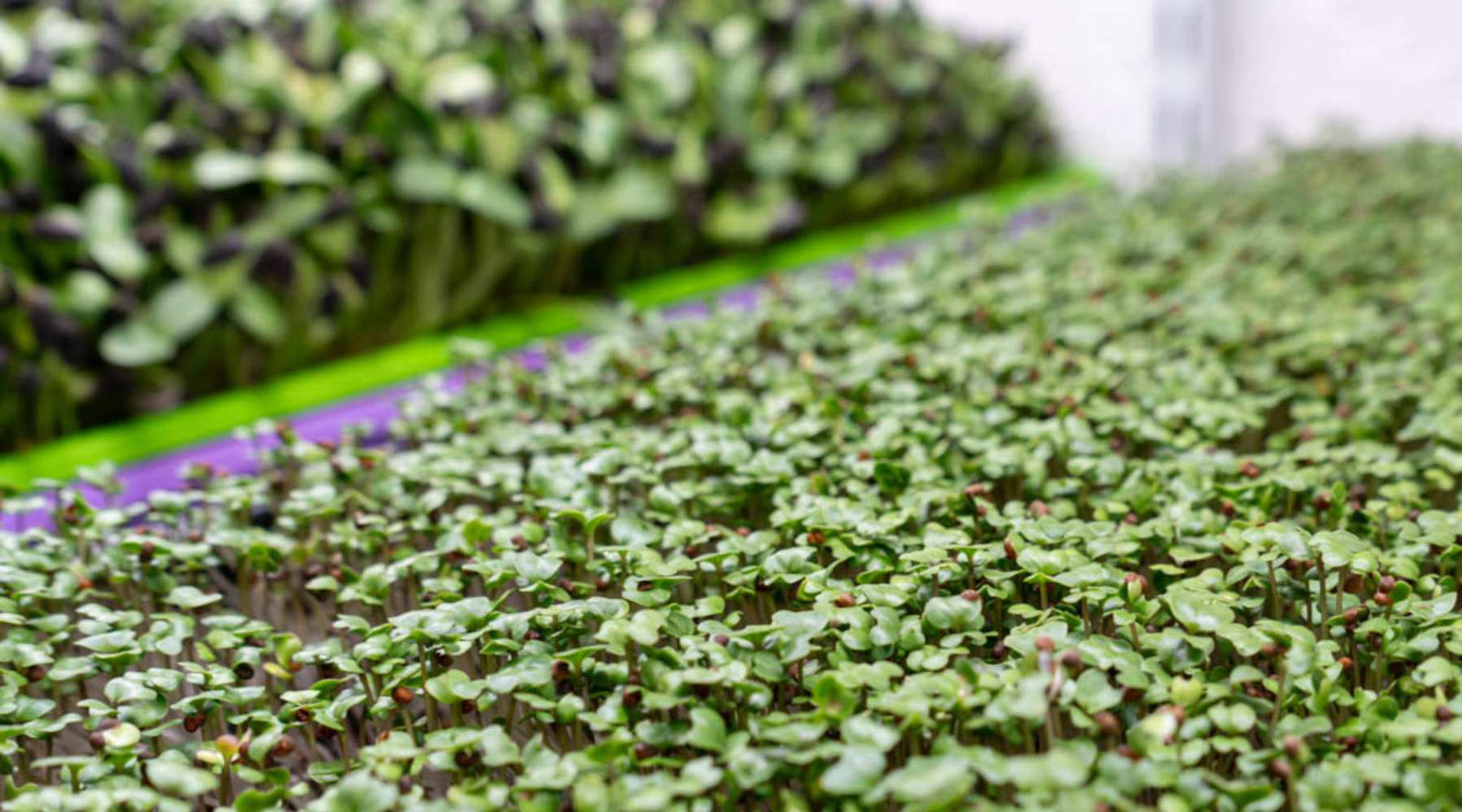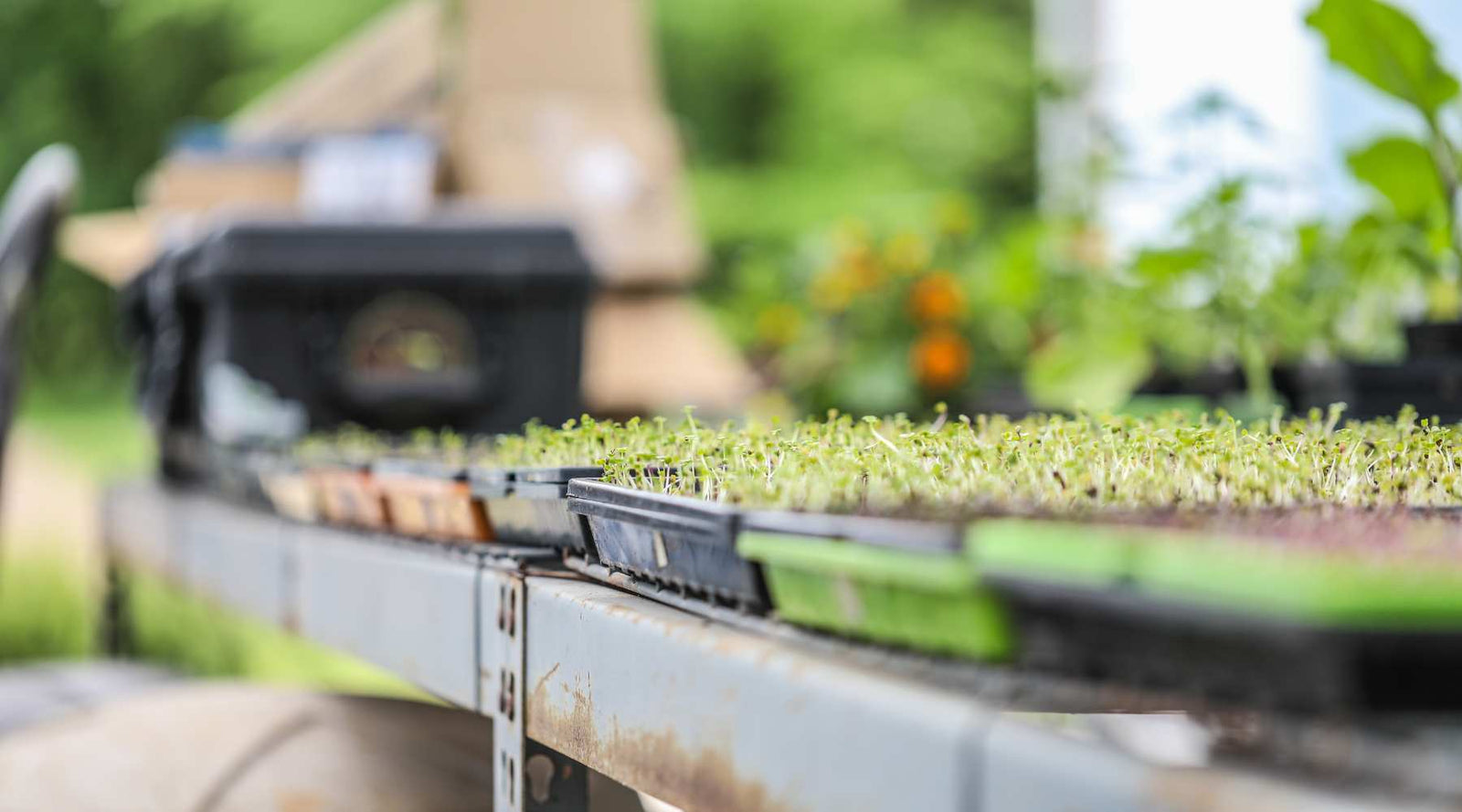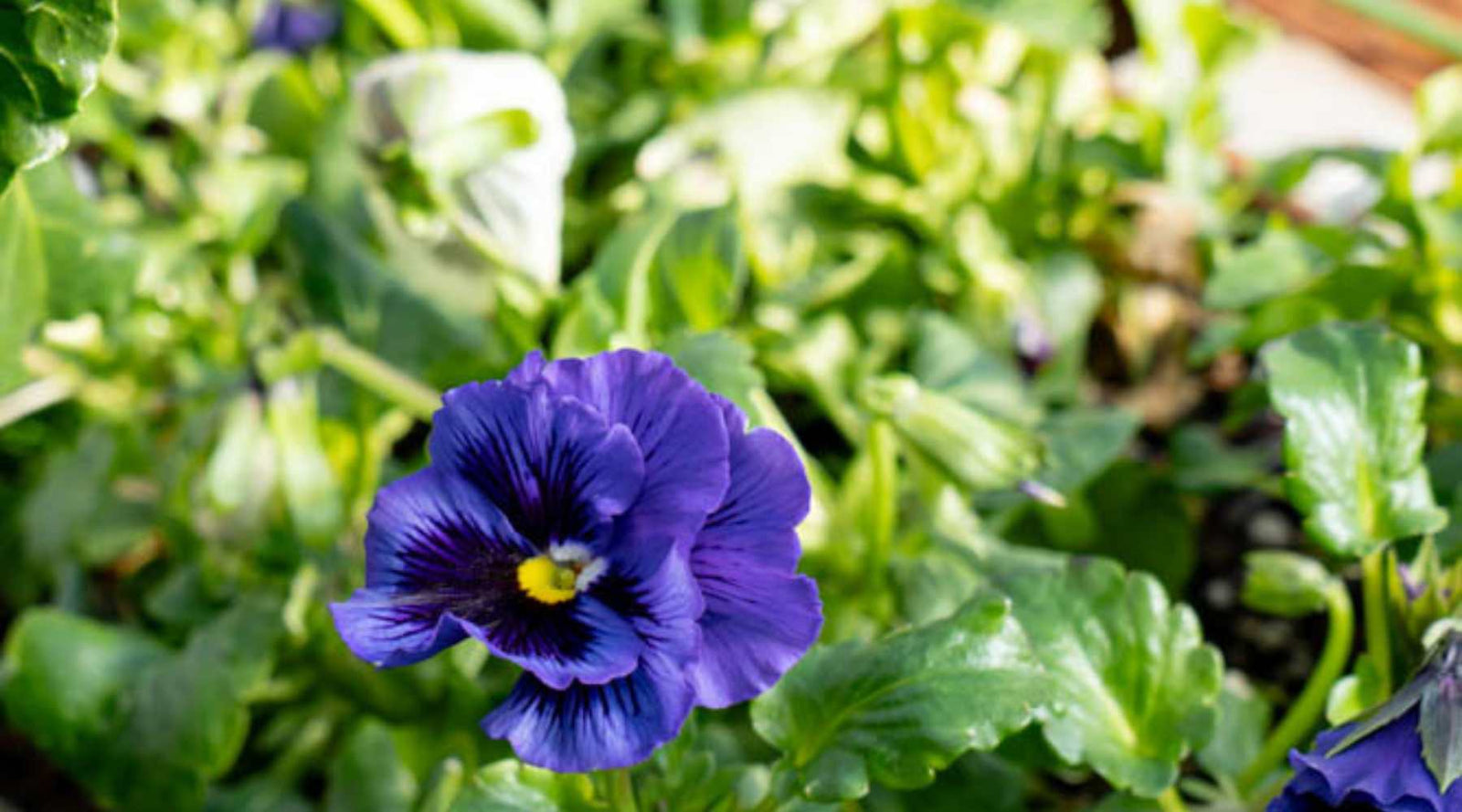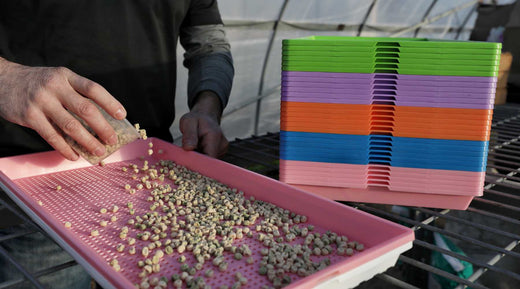Free Shipping on Orders over $75 to the Contiguous US
Free Shipping on Orders over $75 to the Contiguous US
What Trays Do You Need for Microgreens and Propagation?
June 27, 2025 8 min read 0 Comments

Which tray should you use? Learn about all of the Bootstrap Farmer trays in this guide. Find out which trays are best for your purposes.
Propagation trays can be used to grow microgreens, propagate seedlings in soil blocks, or grow fodder for poultry. Not sure what size or type of tray will work best for you?
Read below to learn about the different propagation trays we carry and get recommendations on how to use them.
DO I NEED TRAYS WITH HOLES AND WITHOUT HOLES TO GROW MICROGREENS AND SOIL BLOCKS?
The short answer is yes, you will need both kinds of trays to grow microgreens or soil blocks properly. No matter which size of tray you will be using, you will need one tray with holes to place your soil and seeds in and one tray without holes to hold water.
The sizes you need will depend on your plans, but the list and additional frequently asked questions below will help you decide which trays are best for your plans to grow.
WHAT SIZE OF MICROGREEN TRAY DO I NEED?
Follow this guide to decide which size trays are best for you. If you need more guidance, like whether mesh trays or trays with holes are a better choice for the crops you want to grow, read on.

5X5 Grow Tray - These microgreen trays are ⅛ the size of the heavy-duty 1020 tray. This convenient size works great for subscription microgreen sales and individual sales, as well as small quantities of herbs for home use. The shallow 5x5s are designed to fit 8 within a 1020 shallow tray. Also available in deep!
Related: A Beginner's Guide to Growing Microgreens at Home in 5x5 Trays

1010 Shallow Microgreen Tray W/ and W/out Holes - This microgreen tray is half the size of the 1020 tray. Same style and durability as the 1020 with the same uses. Two of these shallow trays fit nicely inside a shallow 1020 tray for time savings while watering. If you don’t have enough growing space for a 1020 tray you can nest a 1010 with holes within a 1010 no holes as the bottom tray for watering. The 1010 with holes is also designed for use in a flood and drain system.
1010 Deep Tray W/Holes - This tray is 2.5” deep and half the size of a 1020 tray. It is designed to nest inside a 1010 Deep Tray W/out Holes or nest 2 of them in an heavy-duty 1020 2.5” deep tray W/out holes. The 1010 deep tray with holes can also be used in a flood and drain system.
Related: How and When to Use 10x10 Microgreen Trays to Grow Nutrient-Packed Greens

1020 Shallow Mesh - This mesh 1” deep microgreen tray has small holes throughout the entire tray allowing for superior drainage. These are great for varieties that have larger roots and/or benefit from top watering, ie. peas, sunflowers. They drain so easily that water pooling isn’t an issue. Peas and sunflowers have strong enough stems to handle top watering, not recommended for all varieties. Bottom water with a Shallow 1020 Microgreen W/out Holes or use directly in a flood and drain system.
1020 Deep Mesh - This 2.5” mesh microgreen tray is designed for both larger soil block propagation and taller microgreen varieties. It nests perfectly into the 1020 2.5” Deep W/out Hole Trays for bottom watering or works well in a flood and drain system. This is also a popular choice for fodder and wheatgrass growing as the higher sides help keep the crop from spreading outside the footprint of the tray as it approaches harvest.

1020 Shallow Microgreen Tray W/ & W/out Holes - These trays are the most popular for microgreens growers and they come in bright colors! The no-hole style has 32 small holes allowing for drainage as well as bottom watering. They are perfect for any and all varieties. The shallow tray with holes nests perfectly into the shallow tray without holes for the bottom-watering of microgreens.
1020 Extra Strength 2.5” W/ & W/out Holes - The 1020 2.5” W/Holes is great for varieties that do better with more soil media or for use in propagation. The 1020 2.5” without holes is perfect for use as a blackout dome and bottom-watering. The 1020 Deep W/holes nests into the 1020 Deep without holes for bottom-watering sprouted microgreens or large soil blocks.

WHICH TRAYS ARE BEST FOR GROWING MICROGREENS COMMERCIALLY?
The trays that you will need to grow microgreens for sale will depend on what your growing setup is and how you plan to market your greens. Will you be selling harvested microgreens in clamshells or bags? Are you planning to sell live trays or offer a subscription service?
For growing setups; are you growing indoors or in a high tunnel? Do you plan to grow on racks or tables? Do you have a flood and drain system?
For selling harvested greens it is best to grow in 1020 trays. These give you the largest growing area to shelf space ratio. For live tray subscription services 5x5 trays or 1010 trays are great. They can be grown in 1020 trays for ease of care and then transferred to similar sized bottom trays for delivery to the customer.

WHICH TRAYS ARE BEST FOR GROWING MICROGREENS AT HOME?
The best trays for you will depend on how many people you are feeding and how frequently you want to eat microgreens. For a family of 2 using 1010 trays will let you plant a greater variety of greens while saving space. For larger families with kids growing a few 1020 trays per week of favorites like pea shoots and broccoli microgreens is a great start for adding more vegetables to your diet.
Always choose a heavy-duty reusable tray made from food-safe plastic for ease of cleaning and peace of mind.

DO I NEED BOTH TRAYS WITH HOLES AND TRAYS WITHOUT HOLES?
Yes, when growing microgreens you will need to have trays with holes to grow in and trays with no holes for bottom watering and stacking. Even if you plan to grow outdoors in a high tunnel it is best to have bottom trays so you can water from the bottom. Top watering microgreens, especially outdoors, can lead to increased fungal growth and crop loss. The only time this does not apply is if you will be growing in a flood and drain system like our Automated Grow Rack.
For more information on the Best Way to Water Microgreens at each growth stage, check out the linked article.
WHAT IS THE DIFFERENCE BETWEEN MESH TRAYS AND TRAYS WITH HOLES?
Trays with holes are used for the majority of microgreens. They hold moisture well and keep growing media firmly in place. Since most microgreen seeds are quite small their corresponding roots are equally small and will not block the water from being absorbed up into the growing media during bottom watering.
Mesh trays are used for a few varieties of microgreens that benefit from the extra root space and increased access to both drainage and water. These are the larger seeded crops that include pea shoots, wheatgrass, popcorn shoots and fodder trays. Because these plants have larger roots they can end up plugging the drainage holes on trays with smaller holes.

Which Trays are Best Suited for Soil Blocking?
Mesh trays are the most commonly used trays for soil block propagation. This is because the mesh allows for superior drainage, even bottom watering, and does not interfere with the natural air pruning of roots.
For soil blocks under 1” in height, using shallow mesh trays gives you the best access to seedlings. The low profile of these tray makes it easy to care for and remove transplants. For soil blocks 2” or larger the 2.5” deep trays offer more support and containment for larger seedlings and up potted transplants.
In both cases we recommend a tray with no holes of the same depth for easy bottom watering and transportation of your seedlings. Our 1020 mesh trays also fit nicely under our humidity domes for better germination of seeds and protection of clones.

What are mesh trays used for?
Mesh trays are used most commonly for soil blocking when starting seeds. They are also used for growing larger seeded microgreens as described above. Both shallow mesh trays and deep mesh trays can be used for both activities but shallow mesh is better for tiny soil blocks and microgreens.
Deep mesh trays are used most frequently for taller crops like pea shoots or fodder trays. This is because the higher sides help prevent the crop from leaning over the edges of the tray as they grow. Harvesting shorter microgreens from a deep tray can be difficult unless the growing media reaches almost to the top of the tray. Since this is far more media than most microgreen crops need it is wasteful and shallow trays are the better choice for short crops.
Deep mesh trays are great for soil blocks 2” and larger as they provide more support and prevent the blocks from tipping out at the edges.
Can you grow microgreens on screens in mesh trays?
We do not recommend trying to grow microgreens on screens. If you plan to grow hydroponically using a sustainable media like coco coir will allow for more even distribution of water and better germination rates.
Related: Top 5 Best Growing Mediums for Microgreens
HOW MANY TRAYS DO I NEED TO GROW MICROGREENS?
You will need enough trays to have one set growing and another germinating at a time. Ideally having one extra set as well for those weeks that you want to grow more (or forget to clean and sterilize right away). If you plan to eat three trays worth per week a 10 pack would be just right for you.
If you will be growing for market or wholesale, it is best to have at least 4 sets of trays; one germinating, one growing, one ready to harvest, and one waiting to be cleaned.

HOW DO I CLEAN MY MICROGREEN TRAYS?
If you are using our heavy-duty, reusable trays:
- You will start by removing all of the growing media and roots left over from harvest. If you are looking for ways to Reuse Spent Trays of Microgreens this article offers a number of uses.
- Spray the trays off using a hose on a higher pressure setting to remove roots and stuck on growing media.
- Wash the mostly clean trays in hot soapy water or run them through your dishwasher. (Just remember to turn off the heated dry function)
- Rinse your trays with clean water and allow them to air dry.
- For added sterilization, you can use H2O2 or a mild bleach solution as a dip or in a spray bottle before air drying.
- Optional: for larger operations, this commercial tray washer is a timesaving addition.
For more tips on cleaning microgreen trays check out this article.

SHOULD I USE SHALLOW TRAYS OR DEEP TRAYS FOR GROWING MICROGREENS?
For most microgreens, our shallow 1 ¼ inch trays are perfect for saving on growing media and making your plants easy to harvest.
For tall-growing crops like pea shoots, sunflowers, and wheatgrass our deep 2.5 inch trays give your crops a little more support and space for longer growing times. If you only want to have one type of tray in your system, we recommend using the shallow trays.
WANT TO LEARN HOW TO GROW MICROGREENS?
We have compiled all of our best resources from our Microgreens Blog into a single location for your convenience. If you are just starting out and will be growing microgreens at home for yourself, start with our Microgreens 101 resource.
Are ready to step up your growing game or planning to start a microgreens business? Check out our Ultimate Microgreen Growing Resource Guide for information on all steps of the process from what lights to use to how to deal with mold-prone seeds. We also have printable PDFs there for you to use for seed density recommendations and live tray care.
Also in Microgreens Guides & Resources

How to Market Microgreens: Strategies That Get Results
March 27, 2025 13 min read 0 Comments
In this article, we’ll help you stay at the top of your microgreen game to help you succeed in this exciting venture.

Must-Know Tips for Edible Flower Farming Success
October 20, 2025 9 min read 0 Comments
Learn how to expand your markets, what popular edible flowers to offer, marketing tips, new trends, and best practices.

What Lights Do I Need to Grow Microgreens?
January 13, 2025 10 min read 0 Comments
Recent Articles
- How to Market Microgreens: Strategies That Get Results
- Must-Know Tips for Edible Flower Farming Success
- What Lights Do I Need to Grow Microgreens?
- How To Grow Microgreens Indoors - SEED to HARVEST
- A Quick Guide to Starting a Microgreens Business
- How and When to Use 10x10 Microgreen Trays to Grow Nutrient-Packed Greens
- How to Disinfect Seeds Before Planting and Sprouting
- Top 5 Best Growing Mediums for Microgreens
- What Trays Do You Need for Microgreens and Propagation?
- Top Ten Microgreens to Grow
Subscribe
Sign up to get the latest on sales, new releases and more …
